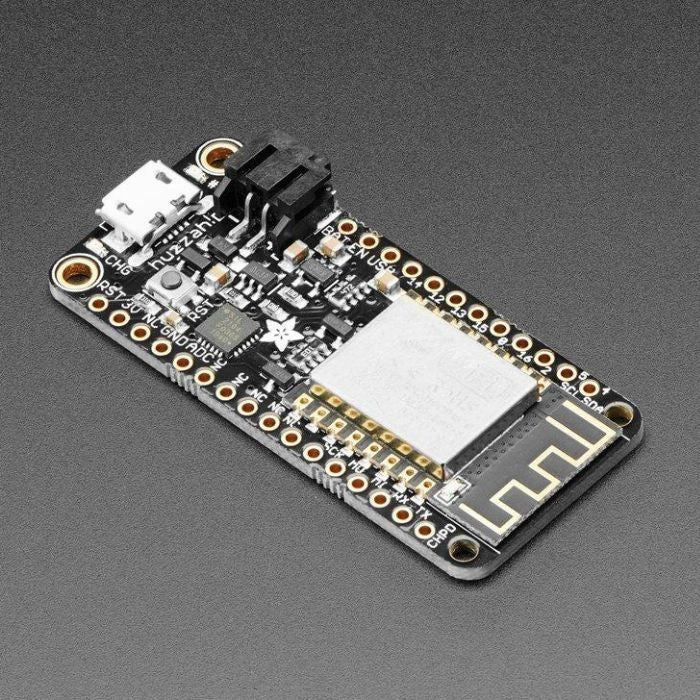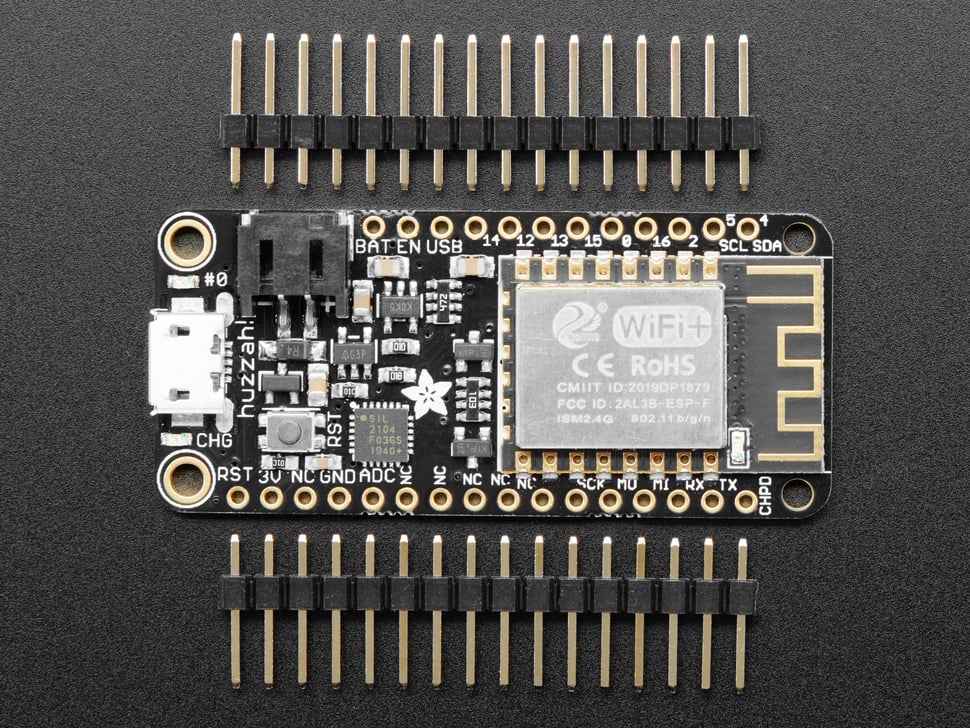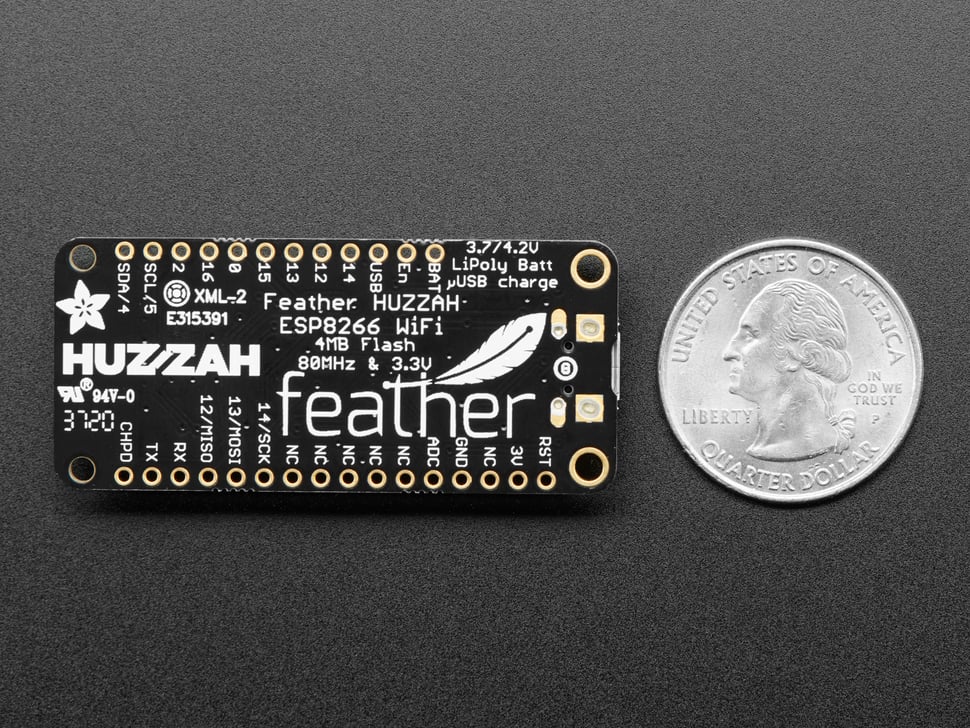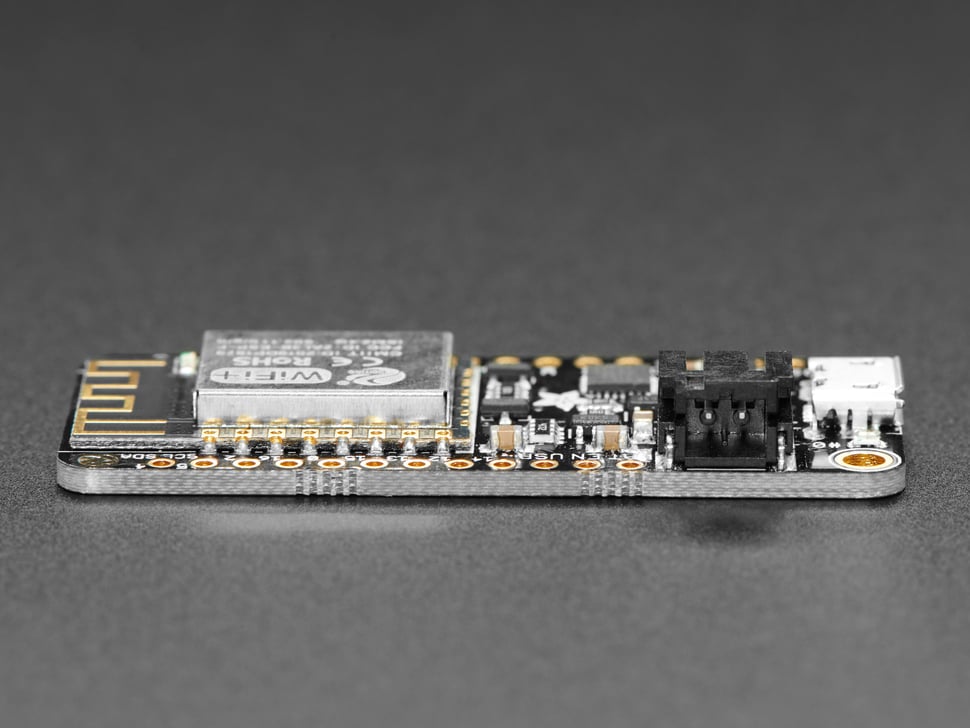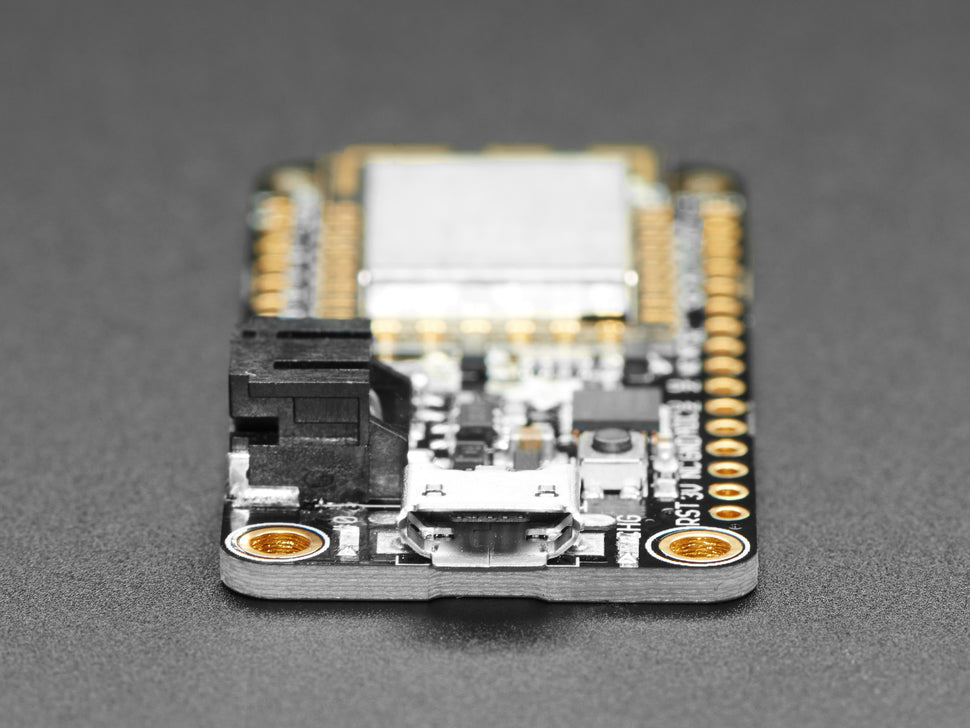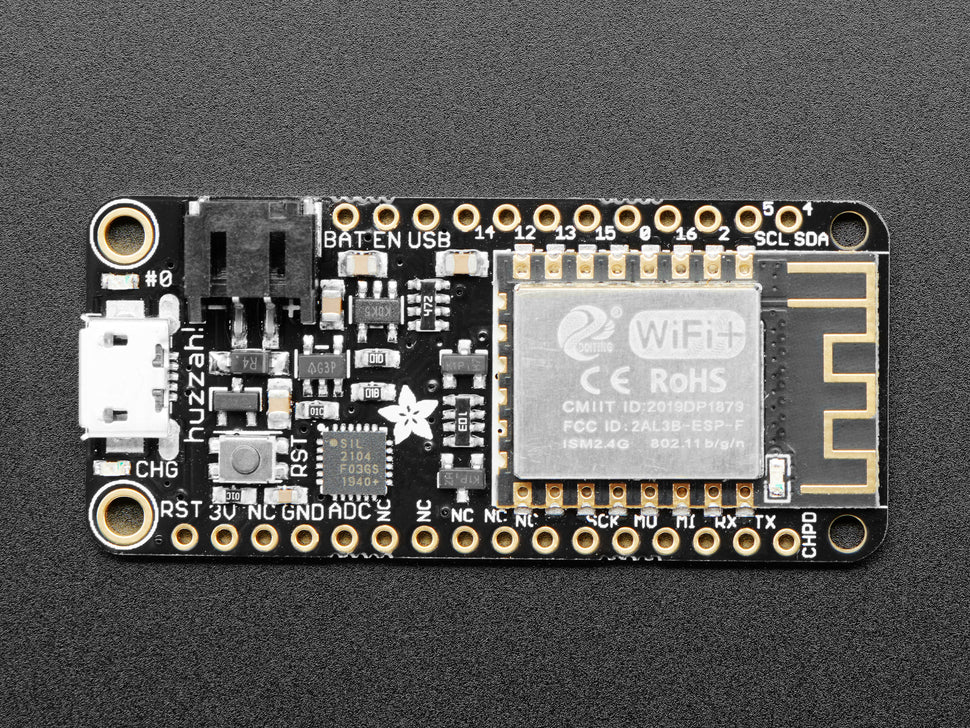Feather ist das neue Entwicklungsboard von Adafruit, und wie sein Namensvetter ist es dünn, leicht und lässt dich fliegen! Adafruit hat Feather entwickelt, um einen neuen Standard für tragbare Mikrocontroller-Kerne zu schaffen.
Dies ist das Adafruit Feather HUZZAH ESP8266 - unsere Version eines "all-in-one" ESP8266 WiFi Entwicklungsboards mit eingebautem USB und Akkuladung. Es ist ein ESP8266 WiFi-Modul mit allen Extras, die Sie brauchen, bereit zu rocken! Adafruit hat noch weitere Boards der Feather-Familie im Angebot, die Sie hier finden.
Das Herzstück des Feather HUZZAH ist ein ESP8266 WiFi-Mikrocontroller, der mit 80 MHz getaktet ist und mit 3,3 V Logik arbeitet. Dieser Mikrocontroller enthält einen Tensilica-Chipkern sowie einen vollständigen WiFi-Stack. Sie können den Mikrocontroller mit der Arduino-IDE programmieren, um einen einfach zu bedienenden Internet-of-Things-Kern zu erhalten. Adafruit hat einen hochwertigen SiLabs CP2104 USB-Seriell-Chip verkabelt, der Code mit 921600 Baud hochladen kann, um die Entwicklungszeit zu verkürzen. Außerdem verfügt er über einen automatischen Reset, so dass man nicht mit Pins herumspielen und Reset-Tasten drücken muss. Der CP2104 hat eine bessere Treiberunterstützung als der CH340 und kann sehr hohe Geschwindigkeiten ohne Stabilitätsprobleme erreichen.
Um die Verwendung für tragbare Projekte zu erleichtern, wurde ein Anschluss für einen unserer 3,7-V-Lithium-Polymer-Akkus und eine integrierte Ladefunktion hinzugefügt. Sie brauchen keinen Akku, er läuft problemlos direkt über den Micro-USB-Anschluss. Wenn du aber einen Akku hast, kannst du ihn mitnehmen und dann zum Aufladen an den USB-Anschluss anschließen. Der Feather schaltet automatisch auf USB-Strom um, wenn dieser verfügbar ist.
Hier sind ein paar praktische Daten!
- Maße: 2,0" x 0,9" x 0,28" (51mm x 23mm x 8mm) ohne eingelötete Anschlüsse
- Leicht wie eine (große?) Feder - 9,7 Gramm
- ESP8266 @ 80MHz mit 3,3V Logik/Stromversorgung
- 4MB FLASH (32 MBit)
- Eingebautes WiFi 802.11 b/g/n
- 3.3V Regler mit 500mA Spitzenstromausgang
- CP2104 USB-Seriell-Wandler mit einer maximalen Baudrate von 921600 für schnelles Hochladen
- Auto-Reset-Unterstützung, um vor dem Firmware-Upload in den Bootload-Modus zu gelangen
- 9 x GPIO-Pins - können auch als I2C und SPI verwendet werden
- 1 x Analogeingänge 1.0V max
- Eingebautes 100mA LiPoly-Ladegerät mit Ladestatusanzeige-LED, kann auch eine Leiterbahn schneiden, um das Ladegerät zu deaktivieren
- Pin #0 rote LED für allgemeine Zwecke blinken. Pin #2 blaue LED für Bootload-Debug & allgemeines Blinken
- Strom-/Einschaltstift
- 4 Befestigungslöcher
- Reset-Taste
Wird komplett zusammengebaut und getestet geliefert, mit einer USB-Schnittstelle, die eine schnelle Nutzung mit der Arduino IDE oder NodeMCU Lua ermöglicht (der Lua-Interpreter ist vorprogrammiert). Adaruit legt auch einige Stiftleisten bei, so dass Sie sie einlöten und in ein lötfreies Breadboard stecken können. Lipoly-Batterie und USB-Kabel sind nicht im Lieferumfang enthalten (aber wir haben viele Optionen im Shop, wenn Sie möchten!)
Schauen Sie sich das Tutorial für alle möglichen Details an, einschließlich Schaltpläne, Dateien, IDE-Anweisungen, Power-Management und mehr!
English Description
Feather is the new development board from Adafruit, and like its namesake, it is thin, light, and lets you fly! We designed Feather to be a new standard for portable microcontroller cores.
This is the Adafruit Feather HUZZAH ESP8266 - our take on an 'all-in-one' ESP8266 WiFi development board with built-in USB and battery charging. It's an ESP8266 WiFi module with all the extras you need, ready to rock! Adafruit has other boards in the Feather family, check'em out here.
At the Feather HUZZAH's heart is an ESP8266 WiFi microcontroller clocked at 80 MHz and at 3.3V logic. This microcontroller contains a Tensilica chip core as well as a full WiFi stack. You can program the microcontroller using the Arduino IDE for an easy-to-run Internet of Things core. Adafruit wired up a high-quality SiLabs CP2104 USB-Serial chip that can upload code at a blistering 921600 baud for fast development time. It also has auto-reset so no noodling with pins and reset button pressings. The CP2104 has better driver support than the CH340 and can do very high speeds without stability issues.
To make it easy to use for portable projects, they added a connector for any of our 3.7V Lithium polymer batteries and built-in battery charging. You don't need a battery, it will run just fine straight from the micro USB connector. But, if you do have a battery, you can take it on the go, then plug in the USB to recharge. The Feather will automatically switch over to USB power when it's available.
Here's some handy specs!
- Measures 2.0" x 0.9" x 0.28" (51mm x 23mm x 8mm) without headers soldered in
- Light as a (large?) feather - 9.7 grams
- ESP8266 @ 80MHz with 3.3V logic/power
- 4MB of FLASH (32 MBit)
- Built in WiFi 802.11 b/g/n
- 3.3V regulator with 500mA peak current output
- CP2104 USB-Serial converter onboard with 921600 max baudrate for speedy uploading
- Auto-reset support for getting into bootload mode before firmware upload
- 9 x GPIO pins - can also be used as I2C and SPI
- 1 x analog inputs 1.0V max
- Built-in 100mA LiPoly charger with charging status indicator LED, can also cut a trace to disable the charger
- Pin #0 red LED for general purpose blinking. Pin #2 blue LED for bootloading debug & general purpose blinking
- Power/enable pin
- 4 mounting holes
- Reset button
Comes fully assembled and tested, with a USB interface that lets you quickly use it with the Arduino IDE or NodeMCU Lua (it comes preprogrammed with the Lua interpreter). Adaruit also tosses in some headers so you can solder them in and plug them into a solderless breadboard. Lipoly battery and USB cable not included (but we do have lots of options in the shop if you'd like!)
Check out their tutorial for all sorts of details, including schematics, files, IDE instructions, power management, and more!
Sicherheitsangaben
- Lesen Sie die Bedienungsanleitung sorgfältig durch, bevor Sie das Produkt verwenden.
- Stellen Sie sicher, dass alle Montage- und Installationsanweisungen des Herstellers sorgfältig befolgt werden.
- Verwenden Sie das Produkt nur für den vorgesehenen Zweck.
- Die unsachgemäße Nutzung dieses Produkts kann zu schweren Verletzungen oder Sachschäden führen.
- Nicht für Kinder unter 10 Jahren geeignet.
- Bei unsachgemäßer Verwendung besteht eine Verletzungsgefahr.
- Dieses Produkt entspricht den geltenden Sicherheitsanforderungen der Europäischen Union.
- Dieses Produkt wurde gemäß der GPSR geprüft, die sicherstellt, dass alle relevanten Sicherheitsanforderungen für Konsumgüter eingehalten werden.
Nachverfolgbarkeitsinformationen
Jedes Produkt verfügt über eines oder mehrere der folgenden Merkmale:
- Ein CE-Kennzeichen, das die Einhaltung der Sicherheits-, Gesundheits- und Umweltschutzanforderungen der Europäischen Union anzeigt.
- Eine eindeutige Serien- oder Chargennummer, um die Nachverfolgbarkeit zu gewährleisten und bei Bedarf Rückrufaktionen zu unterstützen.
- Hersteller- und Importeurangaben für den Kundensupport und Sicherheitsanfragen.
Überwachung und Berichterstattung von Vorfällen
Für den unwahrscheinlichen Fall eines Produktproblems haben wir Verfahren implementiert, um:
- Kundenbeschwerden zeitnah bearbeiten.
- Schwerwiegende Vorfälle über das EU Safety Gate/RAPEX-System melden.
- Mit den Marktüberwachungsbehörden zusammenarbeiten, um die öffentliche Sicherheit zu gewährleisten.
Kontakt:
- Email: support [@] pi3g.com
- Telefon: 0341 / 392 858 40
Dieses Produkt ist vollständig mit allen geltenden EU-Vorschriften konform, um die Sicherheit unserer geschätzten Kunden zu gewährleisten.

